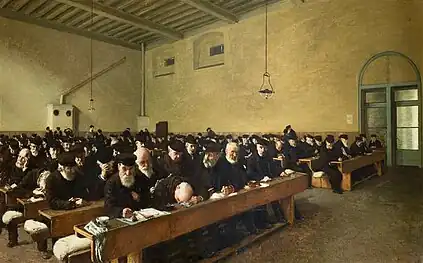
Angelo Morbelli (18 July 1853, Alessandria – 7 November 1919, Milan) was an Italian painter of socially conscious genre scenes. During his later years, he painted in the Divisionist style.
Biography
He was born to Giovanni Morbelli, a government official, and his wife Giovannina, née Feraris. At first he studied music, but contracted mastoiditis, which led to a progressive hearing loss. As a result, he switched to art and began taking drawing lessons from a local artist. In 1867, a grant from the City Council of Alessandria enabled him to enroll at the Brera Academy, where he studied with Giuseppe Bertini and Raffaele Casnedi.[1] Upon graduating, he began to exhibit in Milan and Turin. His early works were primarily landscapes and historical scenes.
His painting of Goethe's death (1880), was the first to bring him to the attention of the general public. In 1883, he changed his focus to contemporary subjects; most notably, depicting the elderly residents of the Pio Albergo Trivulzio, a retirement home and hospital. One of his works from that series, The Last Days, was awarded a gold medal at the Exposition Universelle in 1889.[1] He would go on to produce other series addressing social issues. In the early 1880s he had married Maria Pagani, who inspired several works on motherhood.
Around 1890, he began to experiment with color composition and adopted Divisionism. His initial works in that style were mostly landscapes, including the hills around Casale Monferrato, near a home he had recently purchased, and the farms outside of Vercelli. During the summers, he worked in Santa Caterina Valfurva .
In 1897, his depiction of women working in the rice fields (For Eighty Cents) was awarded the Dresden Gold Medal. At the Exposition Universelle of 1900, he was presented with another gold medal for Day of Celebration at the Pio Albergo Trivulzio. In 1902, he set up a small studio at the hospice and produced a new series of works.[1] During the next decade, he also produced seascapes and more paintings honoring motherhood. Many of his paintings were adapted from photographs.
He spent his last years alternating between winters in Milan and summers in Usseglio. In 1912, he began writing a book on Divisionism, in the form of a private diary. He died of pneumonia, aged sixty-six.[1]
Selected paintings
 The Last Days
The Last Days%252C_by_Angelo_Morbelli.jpg.webp) Hanging Clothes in the Sun
Hanging Clothes in the Sun For Eighty Cents
For Eighty Cents An Interesting Game
An Interesting Game
References
- 1 2 3 4 Biography of Morbelli by Rossella Canuti, from the Dizionario Biografico degli Italiani @ Treccani
Further reading
- Aurora Scotti, Angelo Morbelli, Soncino, 1991
- Silvia Corsetti, Impegno sociale e sperimentali pittorico di A. Morbelli: i due volti del divisionismo, masters thesis, University of Pisa, 2014. Online
External links
- Biography and catalog of works @ the Archivio Angelo Morbelli
- More works by Morbelli @ ArtNet